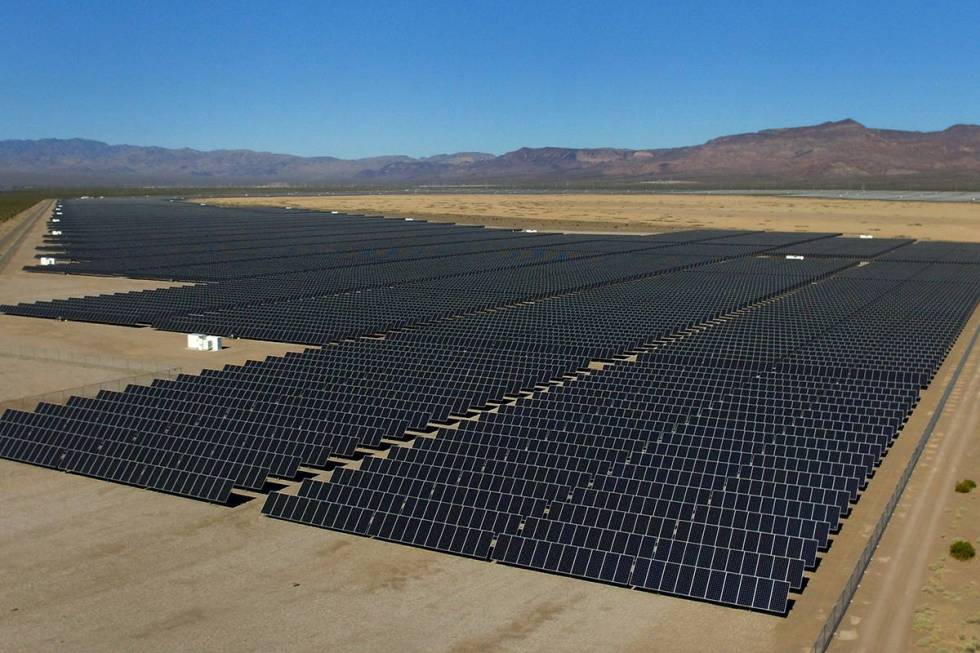Massive solar project north of Las Vegas OK’d by Interior Department

A plan to build the largest solar energy project in the U.S. just north of Las Vegas was approved Monday by the Interior Department.
NV Energy’s Gemini Solar Project, which will be built east of Interstate 15 along the road to Valley of Fire State Park, comes with a $1 billion price tag and is expected to generate enough electricity to power 260,000 homes in the region, according to the department.
U.S. Secretary of the Interior David Bernhardt signed a record of decision for the project, bringing an end to the federal authorization and environmental review process of the proposed plant.
Australia’s Quinbrook Infrastructure Partners is developing the project in collaboration with California-based Arevia Power, which is also managing the development phases.
Upon completion of the first and second construction phases, the 690-megawatt solar plant will span 7,100 acres, making it the largest of its kind in the U.S. and the eighth-largest in the world. It will also include a 380-megawatt, solar-powered battery system to store and deploy power after sundown.
Last year, the Public Utilities Commission approved NV Energy’s Integrated Resource Plan, which would add three projects contributing up to 1,190 megawatts of solar renewable energy to the state, as well as an additional 590 megawatts of energy storage capacity.
Gemini is the first of the two projects to receive state and federal approval.
More solar arrays
The Arrow Canyon Solar Project, a 200-megawatt solar plant with a 75-megawatt battery storage system, is proposed for construction 20 miles northeast of Las Vegas on the Moapa Band of Paiutes Indian Reservation.
A second project — the Southern Bighorn Solar & Storage Center, a 300-megawatt solar array with a 135-megawatt lithium-ion battery energy storage system — is set to be built on the Moapa River Indian Reservation about 30 miles north of Las Vegas.
All three projects would bring NV Energy closer to complying with Senate Bill 358, signed last year by Gov. Steve Sisolak, which requires Nevada energy providers to get at least half of their energy from renewable resources by 2030.
According to the Interior Department, the Gemini project also advances policy objectives described in President Donald Trump’s Executive Order 13783, which promotes “clean and safe development of our Nation’s vast energy resources.”
The approval comes at an apt time, when the COVID-19 pandemic has left many Nevadans out of work and put an extensive drain on the economy.
“This action is about getting Americans back to work, strengthening communities and promoting investment in American energy,” said Casey Hammond, principal deputy assistant secretary for Land and Minerals Management. “Domestic energy production on federal lands remains fundamental to our national security and the achievements of the Trump administration.”
Arevia Power said the project’s on-site construction work force is expected to average 500 to 700 people, with a peak of up to 900 workers during the first phase.
Officials hope the project will create up to 1,100 jobs and inject an estimated $712.5 million into the economy during construction, healing some of the financial hurt caused by the COVID-19 pandemic.
“As our economy rebounds from the invisible enemy, President Trump is working to make the United States stronger than ever before. Our economic resurgence will rely on getting America back to work, and this project delivers on that objective,” Bernhardt said.
The renewable energy generated by the solar plant could also offset the annual greenhouse emissions of 83,000 vehicles, and stipulations in the department’s approval include construction methods that will be less harmful to local wildlife, including the threatened desert tortoise.
Concern for wildlife
Nevada-based environmental group Basin and Range Watch has spoken out against the proposed development, and has begun compiling “before” pictures of the area in advance of construction. The group has insisted that the project is too large and too close to vulnerable wildlife areas.
Surveyors estimated nearly 300 tortoises live within the area designated for construction, and those tortoises will need to be removed before construction and then reintroduced.
But rather than bulldozing the area to make room for solar panels, the Bureau of Land Management and Department of the Interior specified a “hybrid alternative” that involves trimming vegetation instead of removing it.
“Extensive long-term monitoring will be required, in addition to possible adaptation of methods used to reduce potential impacts to desert tortoise,” the department said.
The first construction phase is expected to begin in 2021 and wrap up as early as 2022, the department said.
Contact Max Michor at mmichor@reviewjournal.com or 702-383-0365. Follow @MaxMichor on Twitter.